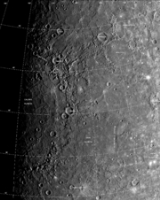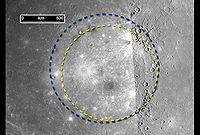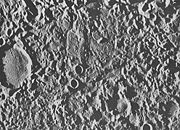
Caloris Basin
Encyclopedia
The Caloris Basin, also called Caloris Planitia, is a large impact crater
on Mercury
about 1550 km (963.1 mi) in diameter
, one of the largest impact basins in the solar system. Caloris is Latin
for heat
and the basin is so-named because the Sun
is almost directly overhead every second time Mercury passes perihelion. The crater, discovered in 1974, is surrounded by a ring of mountain
s approximately 2 km (1.2 mi) tall.
 The Caloris Basin was discovered on images taken by the Mariner 10
The Caloris Basin was discovered on images taken by the Mariner 10
probe in 1974. It was situated on the terminator
—the line dividing the daytime and nighttime hemispheres—at the time the probe passed by, and so half of the crater could not be imaged. Later, on January 15, 2008, one of the first photos of the planet taken by the MESSENGER
probe revealed the crater in its entirety.
 The crater was initially estimated to be about 1300 km (807.8 mi) in diameter, though this was increased to 1550 km (963.1 mi) based on subsequent images taken by MESSENGER. It is ringed by mountains up to 2 km (1.2 mi) high. Inside the crater walls, the floor of the crater is filled by lava plains, similar to the maria
The crater was initially estimated to be about 1300 km (807.8 mi) in diameter, though this was increased to 1550 km (963.1 mi) based on subsequent images taken by MESSENGER. It is ringed by mountains up to 2 km (1.2 mi) high. Inside the crater walls, the floor of the crater is filled by lava plains, similar to the maria
of the Moon
. Outside the walls, material ejected in the impact which created the basin extends for 1000 km (621.4 mi), and concentric rings surround the crater.
 In the center of the basin is a region containing numerous radial troughs that appear to be extensional fault
In the center of the basin is a region containing numerous radial troughs that appear to be extensional fault
s, with a 40 km (24.9 mi) crater located near the center of the pattern. The exact cause of this pattern of troughs is not currently known. The feature is named Pantheon Fossae
.
s are seen on its floor than exist on comparably-sized regions outside the crater. Similar impact basins on the Moon such as the Mare Imbrium
and Mare Orientale
are believed to have formed at about the same time, possibly indicating that there was a 'spike' of large impacts towards the end of the heavy bombardment phase of the early solar system. Based on MESSENGER's photographs, Caloris' age has been determined to be between 3.8 and 3.9 billion years.

 The giant impact believed to have formed Caloris may have had global consequences for the planet. At the exact antipode
The giant impact believed to have formed Caloris may have had global consequences for the planet. At the exact antipode
of the basin is a large area of hilly, grooved terrain, with few small impact craters that are known as the Chaotic Terrain (also 'Weird Terrain'). It is thought by some to have been created as seismic wave
s from the impact converged on the opposite side of the planet. Alternatively, it has been suggested that this terrain formed as a result of the convergence of ejecta at this basin’s antipode. This hypothetical impact is also believed to have triggered volcanic activity
on Mercury, resulting in the formation of smooth plains. Surrounding Caloris Basin is a series of geologic formations thought to have been produced by the basin's ejecta, collectively called the Caloris Group
.
and helium
captured from the solar wind
, as well as heavier elements such as sodium
and potassium
. These are thought to originate within the planet, being 'out-gassed' from beneath its crust. The Caloris Basin has been found to be a significant source of sodium and potassium, indicating that the fractures created by the impact facilitate the release of gases from within the planet. The Weird Terrain is also a source of these gases.
Impact crater
In the broadest sense, the term impact crater can be applied to any depression, natural or manmade, resulting from the high velocity impact of a projectile with a larger body...
on Mercury
Mercury (planet)
Mercury is the innermost and smallest planet in the Solar System, orbiting the Sun once every 87.969 Earth days. The orbit of Mercury has the highest eccentricity of all the Solar System planets, and it has the smallest axial tilt. It completes three rotations about its axis for every two orbits...
about 1550 km (963.1 mi) in diameter
Diameter
In geometry, a diameter of a circle is any straight line segment that passes through the center of the circle and whose endpoints are on the circle. The diameters are the longest chords of the circle...
, one of the largest impact basins in the solar system. Caloris is Latin
Latin
Latin is an Italic language originally spoken in Latium and Ancient Rome. It, along with most European languages, is a descendant of the ancient Proto-Indo-European language. Although it is considered a dead language, a number of scholars and members of the Christian clergy speak it fluently, and...
for heat
Heat
In physics and thermodynamics, heat is energy transferred from one body, region, or thermodynamic system to another due to thermal contact or thermal radiation when the systems are at different temperatures. It is often described as one of the fundamental processes of energy transfer between...
and the basin is so-named because the Sun
Sun
The Sun is the star at the center of the Solar System. It is almost perfectly spherical and consists of hot plasma interwoven with magnetic fields...
is almost directly overhead every second time Mercury passes perihelion. The crater, discovered in 1974, is surrounded by a ring of mountain
Mountain
Image:Himalaya_annotated.jpg|thumb|right|The Himalayan mountain range with Mount Everestrect 58 14 160 49 Chomo Lonzorect 200 28 335 52 Makalurect 378 24 566 45 Mount Everestrect 188 581 920 656 Tibetan Plateaurect 250 406 340 427 Rong River...
s approximately 2 km (1.2 mi) tall.
Appearance

Mariner 10
Mariner 10 was an American robotic space probe launched by NASA on November 3, 1973, to fly by the planets Mercury and Venus. It was launched approximately two years after Mariner 9 and was the last spacecraft in the Mariner program...
probe in 1974. It was situated on the terminator
Terminator (solar)
A terminator, twilight zone or "grey line" is a moving line that separates the illuminated day side and the dark night side of a planetary body...
—the line dividing the daytime and nighttime hemispheres—at the time the probe passed by, and so half of the crater could not be imaged. Later, on January 15, 2008, one of the first photos of the planet taken by the MESSENGER
MESSENGER
The MErcury Surface, Space ENvironment, GEochemistry and Ranging space probe is a robotic NASA spacecraft in orbit around the planet Mercury. The spacecraft was launched aboard a Delta II rocket in August 2004 to study the chemical composition, geology, and magnetic field of Mercury...
probe revealed the crater in its entirety.

Lunar mare
The lunar maria are large, dark, basaltic plains on Earth's Moon, formed by ancient volcanic eruptions. They were dubbed maria, Latin for "seas", by early astronomers who mistook them for actual seas. They are less reflective than the "highlands" as a result of their iron-rich compositions, and...
of the Moon
Moon
The Moon is Earth's only known natural satellite,There are a number of near-Earth asteroids including 3753 Cruithne that are co-orbital with Earth: their orbits bring them close to Earth for periods of time but then alter in the long term . These are quasi-satellites and not true moons. For more...
. Outside the walls, material ejected in the impact which created the basin extends for 1000 km (621.4 mi), and concentric rings surround the crater.

Extensional fault
An extensional fault is a fault that vertically thins and horizontally extends portions of the Earth's crust and/or lithosphere. In most cases such a fault is also a normal fault, but may be rotated to have a shallower geometry normally associated with a thrust fault...
s, with a 40 km (24.9 mi) crater located near the center of the pattern. The exact cause of this pattern of troughs is not currently known. The feature is named Pantheon Fossae
Pantheon Fossae
Pantheon Fossae is a region in the center of Caloris Basin on Mercury containing numerous radial graben that appear to be extensional faults, with a 40 km crater located near the center of the pattern. The exact cause of this pattern of troughs is not currently known...
.
Formation
Bodies in the inner solar system experienced a heavy bombardment of large rocky bodies in the first billion years or so of the solar system. The impact which created the Caloris Basin must have occurred after most of the heavy bombardment had finished, because fewer impact craterImpact crater
In the broadest sense, the term impact crater can be applied to any depression, natural or manmade, resulting from the high velocity impact of a projectile with a larger body...
s are seen on its floor than exist on comparably-sized regions outside the crater. Similar impact basins on the Moon such as the Mare Imbrium
Mare Imbrium
Mare Imbrium, Latin for "Sea of Showers" or "Sea of Rains", is a vast lunar mare filling a basin on Earth's Moon and one of the larger craters in the Solar System. Mare Imbrium was created when lava flooded the giant crater formed when a very large object hit the Moon long ago...
and Mare Orientale
Mare Orientale
Mare Orientale is one of the most striking large scale lunar features, resembling a target ring bull's-eye. Located on the extreme western edge of the lunar nearside, this impact basin is difficult to see from an Earthbound perspective.Material from this basin was not sampled by the Apollo program...
are believed to have formed at about the same time, possibly indicating that there was a 'spike' of large impacts towards the end of the heavy bombardment phase of the early solar system. Based on MESSENGER's photographs, Caloris' age has been determined to be between 3.8 and 3.9 billion years.
Antipodal chaotic terrain and global effects


Antipodal point
In mathematics, the antipodal point of a point on the surface of a sphere is the point which is diametrically opposite to it — so situated that a line drawn from the one to the other passes through the centre of the sphere and forms a true diameter....
of the basin is a large area of hilly, grooved terrain, with few small impact craters that are known as the Chaotic Terrain (also 'Weird Terrain'). It is thought by some to have been created as seismic wave
Seismic wave
Seismic waves are waves of energy that travel through the earth, and are a result of an earthquake, explosion, or a volcano that imparts low-frequency acoustic energy. Many other natural and anthropogenic sources create low amplitude waves commonly referred to as ambient vibrations. Seismic waves...
s from the impact converged on the opposite side of the planet. Alternatively, it has been suggested that this terrain formed as a result of the convergence of ejecta at this basin’s antipode. This hypothetical impact is also believed to have triggered volcanic activity
Volcano
2. Bedrock3. Conduit 4. Base5. Sill6. Dike7. Layers of ash emitted by the volcano8. Flank| 9. Layers of lava emitted by the volcano10. Throat11. Parasitic cone12. Lava flow13. Vent14. Crater15...
on Mercury, resulting in the formation of smooth plains. Surrounding Caloris Basin is a series of geologic formations thought to have been produced by the basin's ejecta, collectively called the Caloris Group
Caloris Group
The Caloris group is a set of geologic units on Mercury. McCauley and others have proposed the name “Caloris Group” to include the mappable units created by the impact that formed the Caloris Basin and have formally named four formations within the group, which were first recognized and named...
.
Emissions of gas
Mercury has a very tenuous and transient atmosphere, containing small amounts of hydrogenHydrogen
Hydrogen is the chemical element with atomic number 1. It is represented by the symbol H. With an average atomic weight of , hydrogen is the lightest and most abundant chemical element, constituting roughly 75% of the Universe's chemical elemental mass. Stars in the main sequence are mainly...
and helium
Helium
Helium is the chemical element with atomic number 2 and an atomic weight of 4.002602, which is represented by the symbol He. It is a colorless, odorless, tasteless, non-toxic, inert, monatomic gas that heads the noble gas group in the periodic table...
captured from the solar wind
Solar wind
The solar wind is a stream of charged particles ejected from the upper atmosphere of the Sun. It mostly consists of electrons and protons with energies usually between 1.5 and 10 keV. The stream of particles varies in temperature and speed over time...
, as well as heavier elements such as sodium
Sodium
Sodium is a chemical element with the symbol Na and atomic number 11. It is a soft, silvery-white, highly reactive metal and is a member of the alkali metals; its only stable isotope is 23Na. It is an abundant element that exists in numerous minerals, most commonly as sodium chloride...
and potassium
Potassium
Potassium is the chemical element with the symbol K and atomic number 19. Elemental potassium is a soft silvery-white alkali metal that oxidizes rapidly in air and is very reactive with water, generating sufficient heat to ignite the hydrogen emitted in the reaction.Potassium and sodium are...
. These are thought to originate within the planet, being 'out-gassed' from beneath its crust. The Caloris Basin has been found to be a significant source of sodium and potassium, indicating that the fractures created by the impact facilitate the release of gases from within the planet. The Weird Terrain is also a source of these gases.

